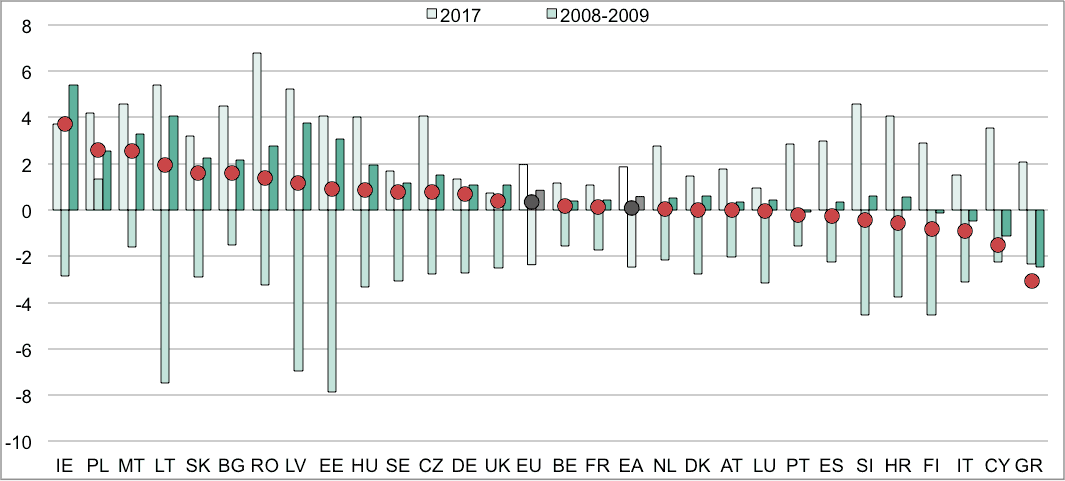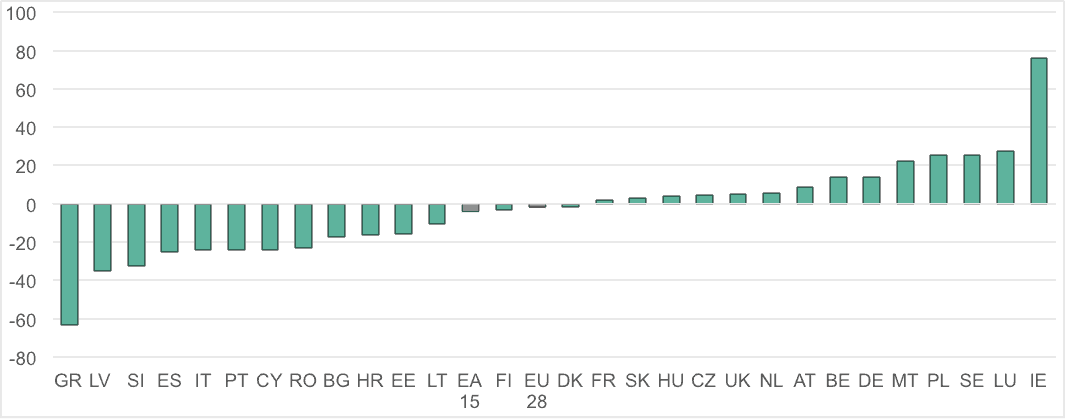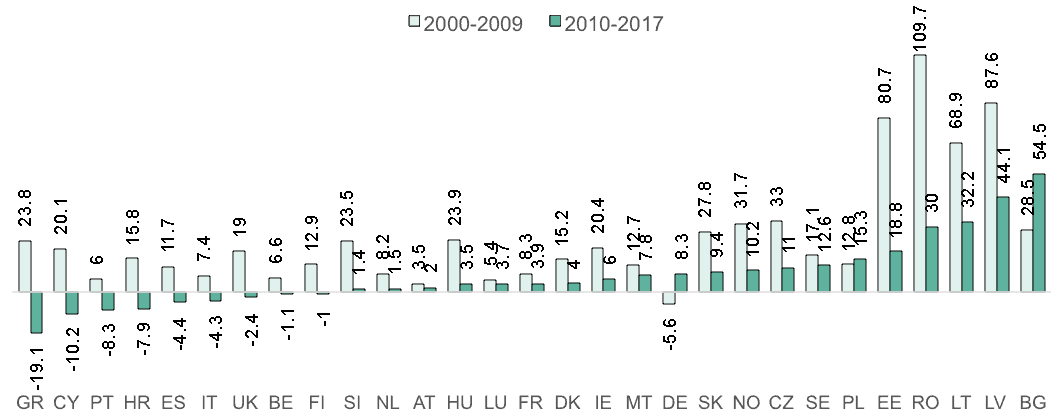The financial and Eurozone crises are now fading into memory. Firm growth has returned to Europe. Jobs are being created and new companies formed. Things should be looking up at last. Why aren’t they?
Several reasons. First, only some economies are growing, while others are stagnating or still shrinking. Second, the jobs recovery is largely in part time and precarious work. Third, employees are not sharing in the recovery through pay rises. And, fourth, a lot more needs to be done to ensure the next recession is nothing like as severe as the last one. Benchmarking Working Europe 2018, the annual stock-take of economic and social progress in Europe published by the ETUI, found multiple reasons for disquiet amid the euphoria creeping into policymaking circles.
Growth for everyone?
First, the economy. While recent macro-economic indicators point to a slight increase in GDP growth across Europe, the positive numbers should be set against the long period of stagnation and/or negative growth that preceded it, so there is a lot of catching up to do. Moreover, the improvement in the economic environment is not being shared equally. Although higher income countries appear to be leaving the crisis behind, others are not. While the pre-crisis period saw economies in the north-west, south and east of the European continent largely converging with each other, this process has since been thrown into reverse.
The ETUI’s analysis shows that average GDP per capita growth remained negative for eight countries between 2008 and 2016, and close to zero for another seven during the crisis period. Fig. 1, below, underlines the strong regional dimension to these disparities. While the mainly central and eastern European countries which joined the EU after 2004 have been catching up with the richer north-western countries, a gap has now opened up between these member states and the poorer economies in the south.
Figure 1: Average annual growth rate (%) in real GDP per capita (EU Member States) (2008-2009, 2010-2016, 2017 and 2008-2016).

Source: ETUI
It’s not surprising that so few of us – companies and wage earners alike – are feeling euphoric about the recovery. Private consumption in Europe remains barely above its pre-crisis level and investment is lower than in 2008 with, again, a clear divide between the growing north and the struggling south (see Fig. 2 below).
Figure 2: Gross fixed capital formation (2007-2017) (percentage change, 2010 prices)

It’s difficult to generalise about the causes of this divergence. But a leading culprit is clearly the lingering effects of austerity and internal devaluations. Countries exposed to the reform programmes of the Commission, ECB and IMF ‘Troika’ were obliged to commit to structural reforms in return for help in stabilising their financial sectors. The conditions attached to these reforms were harsh. Many southern European countries experienced sharp cuts in public sector pay, freezes in minimum wages and benefits, and extensive interference in their collective bargaining systems.
Notably, the pervasive idea that budget surpluses produce growth was also at play in non-eurozone countries outside the Troika’s jurisdiction. The UK was another country which tackled its fiscal deficit through austerity, and its Conservative-led government did so by choice. Austerity was coupled with continued labour market deregulation that fueled growth in zero-hours contracts and other forms of precarious employment. Accordingly, while the UK economy emerged early from the crisis it has been saddled with a chronic problem of low productivity which will hinder its ability to grow out of its post-Brexit slump.
Where’s the pay rise?
Both the European Commission and ECB are now belatedly calling for growth in wages to boost demand. Signs of growing tightness in labour markets should also be leading to a sustained uptick in pay. So why aren’t we seeing this?
Prior to the crisis, wage rates were converging upwards across Europe, but this is no longer happening. Instead, eastern and southern European countries are decoupling from the rich west in terms of pay settlements, and the 2016 trend of wages outstripping productivity has been reversed in many countries. Real wages in nine countries are below what they were in 2010. Only in three countries – Bulgaria, Poland and Germany – did real wage growth between 2010 and 2017 exceed that between 2000 and 2009, a period in which the biggest of these, Germany, had seen a prolonged wage squeeze (see Fig. 3 below).
Figure 3: Development of real compensation (2000-2009 and 2010-2017)

Years of austerity policies have obviously not been good for incomes. Too many governments – in both eastern and western Europe – have also set a minimum wage which is below the poverty threshold. As a result, in many countries being in work is no longer a guarantee of avoiding poverty and indices of in-work poverty remain at the high level it reached at the height of the crisis, with women hit particularly hard. Those in work remain anxious about the future. According to OECD data analysed by the ETUI (p. 44), labour market insecurity in almost all EU member states was higher in 2013 than 2007.
Serious skills mismatches are another legacy. While a high level of skills provides some insurance against poverty and unemployment, it’s no longer a cast-iron guarantee of a good career. A quarter of elementary jobs were taken by highly educated workers between 2014 and 2017, compared with a figure of 11% in the pre-crisis period, the ETUI has found (p. 30). Youth unemployment remains a serious problem in many countries.
What are policymakers doing?
The Juncker Commission has pledged to win a ‘triple social A’ for Europe through the new European Pillar for Social Rights, which provides a compass for gauging common social standards across the EU, and it has set up a Social Scoreboard to provide policy advice for the European Semester.
This is a welcome change of attitude, and the EPSR is a particularly encouraging development. But it is a soft mode of coordination that lacks teeth and needs to be backed by real commitment. While the EU has delivered greater consultation rights for workers, many of these are difficult to deliver in practice, despite strong evidence that countries with stronger ‘worker voice’ are more cohesive (p. 76).
In terms of macro-economic policy, while Commission policymakers are increasingly ready to countenance a modestly positive fiscal stance and more flexibility in the Stability and Growth Pact, this view is still not shared by all member states and the Commission’s own investment plan remains too small to compensate. It also needs to send clear signals that the de-collectivisation of bargaining and labour market liberalisation have gone too far. Insecure, unhappy workers do not make good employees, and firms won’t bother to train their staff if it’s easier to get rid of them and find someone else.
Acknowledging the depth of the crisis that has now passed, the policy mistakes that prolonged it and the risks that structural fissures in the EU pose for future economic stability would be welcome. Real pay rises and action to boost growth and investment would be even better.
Steve Coulter is head of communications at the European Trade Union Institute and a visiting fellow in the European Institute of the London School of Economics and Political Science.
